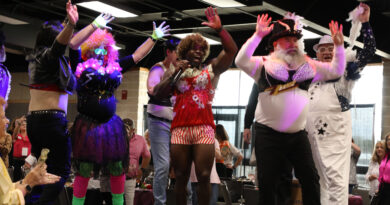Westcave Preserve shares her secrets
Explore the hidden crown jewel of the Texas Hill Country
As education director at Westcave Preserve outside Austin, Paul Vickery enjoys job perks any naturalist would envy. Golden-cheeked warblers. Towering cypress trees. An emerald green grotto with a spring-fed waterfall that flows year-round. But above all the splendor that Mother Nature has bestowed on what’s called the “Crown Jewel” of the Texas Hill Country, it’s the schoolchildren that make Vickery’s job most gratifying.
“It never gets old. You hear the kids, after they’ve gone down the staircase and they’ve seen the creeks, they say, ‘This is the best field trip ever,’” Vickery said, seated at a picnic table on a warm, clear spring day. “I’ve had kids say, ‘This is pure nature,’ with outstretched arms. To have a child, eight, 10, sometimes 12 years old say something that profound or that simple about this place is refreshing — to know that you are fulfilling your mission to not only protect this place but let its story be inspiring and really hit home.”
Westcave Preserve is a 76-acre Shangri-La hidden in the limestone hills 30 miles west of Austin. Unlike state parks, camping is not allowed. Visitors must follow two simple rules: stay on trails and no collecting anything. Docents lead groups of about 25 on the one-hour hike which courses one mile round trip under a canopy of various oak, elm and cypress trees.
First stop is a stunning overlook of the clear-flowing Pedernales River, gurgling and weaving over limestone bedrock 250,000 years old. Further down the trail, visitors grip handrails and trod rustic steps fashioned from cedar and stone and descend into the canyon’s mouth.
Descending slowly, between rock crevices and monstrous boulders, the grotto and waterfall appear like out of a fairy tale. The common reaction: mouth agape followed by an exclamation such as — WOW!
“It takes your breath away. It’s just amazing,” said Amber Gosselin, Westcave Conservation Director who grew up here in the 1970s. “When they (visitors) come around the corner and stand on the bridge, I just love to see their faces.”
At the bottom of the canyon lies a pool 20 feet deep, home to the Central Stoneroller, a member of the minnow family. The name is an apt label because males roll stones around to form nests where females lay eggs.
Down in this moist and fragile ecosystem, sunlight merely trickles through the treetops, seldom shining directly on the grotto itself in summer.
Consequently, most of the rocks and boulders and canyon walls are covered with lichens and ferns. The subterranean landscape is shrouded in a soft, green glow.
The waterfall, which flows year-round thanks to a spring-fed tributary called Heinz Branch, has been etched by the hands of time working in conjunction with simple geology. The water methodically erodes and undercuts the softer sand and shale layers, which lie below the dense limestone. The result is an overhanging stone balcony, adorned with native flora and rhythmically shedding water into the pool 20 feet below.
At the trail’s terminus lies a small cave with growing stalactites and stalagmites. Decades ago, before access to Westcave was controlled, people broke off numerous stalactite tips, evidence why the preserve is closely guarded today. The temperature here in nature’s basement averages 10-12 degrees below what’s recorded on the open spaces above.
Back on high ground, visitors are encouraged to hike the Uplands, a 45-acre tract of classic Hill Country landscape. The trail is wheelchair and stroller friendly and affords several resting spots with sturdy benches sitting in the shade of hardy live oaks.
A bird blind near the trail’s entry affords opportunities for close encounters with hummingbirds, purple martins, black-crested titmouse and perhaps an eastern screech owl — patience and silence rewarded. Two pairs of the endangered golden-cheeked warbler also nest at Westcave from spring to early fall.
John Ahrns — beloved Westcave icon
To protect Westcave’s delicate ecosystem, volunteers and staff members impress upon visitors to take only memories and photos and leave nothing more than footprints.
But one man’s indelible mark stands out among all the benefactors, volunteers, staff and visitors.
John Ahrns moved his wife and two young children to Westcave in 1974, when it was a remote and private 25-acre tract overrun with trespassers. Empty bottles and beer cans, paper trash and broken glass littered the grotto floor and surrounding area. The limestone formations, now lush and green, were trammeled and barren.
As the first full-time paid resident and gatekeeper, Ahrns turned away people who felt entitled to do whatever they wanted. But at the same time, he befriended nearby landowners. Ahrns and friends and other volunteers slowly turned the tide and the grotto began to heal.
Amber Gosselin was 3 years old when her father moved the family to Westcave in a bus borrowed from a family friend. Gosselin said the locals dubbed him Grizzly Adams because he wore a beard and long hair, embraced nature and exuded a live and live attitude. But his friendly demeanor did not mean he was a pushover when it came to trespassers. His stern enforcement of controlled access earned him another moniker: Law West of the Pedernales.
Gosselin still treasures those childhood memories living at Westcave when it was a far-flung outpost straddling the banks of the Pedernales.
“I can’t imagine coming out here with two small kids and it’s just wild. I mean, nothing out here,” said Gosselin. “We didn’t have indoor plumbing. We had an outhouse. For me it was completely normal because it was all I knew.”
Because the Ahrns family had no phone, they kept in contact with neighbors via a CB radio like the ones long-haul truckers use. One wet year, the family was cut off from civilization. The river had swamped the bridge leading to Austin.
“I was a teenager and wanted to be with my friends. And I was going crazy. I called my friend and said meet me down on the river and my dad canoed me across so I could go out with my friends. Country life!”
During Ahrns tenure at Westcave, the preserve grew in size and scope. John Covert Watson, the man who bought the Westcave tract in 1974 and hired Ahrns to mange it, negotiated a deal with the Lower Colorado River Authority.
The LCRA bought Westcave and then signed a 99-year lease with the newly formed nonprofit Westcave Preserve Corporation. Today, Westcave pays one dollar a year for the authority to manage the preserve.
In 2003, the 3,000-square-foot Warren Skaaren Environmental Learning Center opened on a site selected by Ahrns.
The center is named for Skaaren, an accomplished screenwriter — “Top Gun,” “Beetlejuice” and “Batman” — who made an important donation to the building fund. A model of green architecture, the frame is built from recycled steel; solar panels supplement electricity needs, and a water collection system harness rooftop runoff.
A solar observatory tracks the sun’s arc across the sky through the four seasons. A library, artifact display case, photos, drawings and illustrations explain in straightforward language the history, geology, plant and animal life visitors will see at Westcave.
But back to those tours Vickery takes schoolchildren on four days a week, he says Westcave can provide a memorable moment that lasts a lifetime.
“When they get down to that grotto, come across that footbridge, they’re just like wow. ‘I’m in Texas? I just can’t believe this.’”




